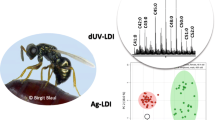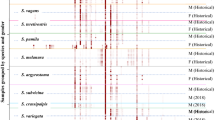Abstract
Insect cuticular hydrocarbons (CHCs) are not only essential for desiccation resistance, they also play an important role as chemical signals and cues in social as well as solitary insects. The identification of CHCs is, therefore, crucial to an understanding of the chemical communication within and between insect species. We describe a method for rapid, simple, and unambiguous identification of CHCs using gas chromatography—ion-trap mass spectrometry. External ionization configuration in combination with a low ion-trap temperature resulted in dramatically increased intensities of molecular ions for alkanes, alkenes and alkadienes, and in high-mass fragmentation patterns with intense ions characteristic for methyl-branched hydrocarbons comparable to those obtained with quadrupole instruments. Additionally, we present an external chemical ionization—tandem mass-spectrometric method that allows for the determination of double-bond positions in alkenes and alkadienes without the need for derivatization prior to analysis.




Similar content being viewed by others
References
Carlson, D. A., Bernier, U. R., and Sutton, B. D. 1998. Elution patterns from capillary GC for methyl-branched alkanes. J. Chem. Ecol. 24:1845–1865.
Cvacka, J., Jiros, P., Sobotnik, J., Hanus, R., and Svatos, A. 2006. Analysis of insect cuticular hydrocarbons using matrix-assisted laser desorption/ionization mass spectrometry. J. Chem. Ecol. 32:409–434.
Doolittle, R. E., Proveaux, A. T., Alborn, H. T., and Heath, R. R. 1995. Quadrupole storage mass spectrometry of mono- and dimethylalkanes. J. Chem. Ecol. 21:1677–1695.
Dunkelblum, E., Tan, S. H., and Silk, P. J. 1985. Double-bond location in monounsaturated fatty-acids by dimethyl disulfide derivatization and mass-spectrometry—application to analysis of fatty-acids in pheromone glands of four Lepidoptera. J. Chem. Ecol. 11:265–277.
Everaerts, C., Farine, J.-P., Cobb, M., and Ferveur, J.-F. 2010. Drosophila cuticular hydrocarbons revisited: Mating status alters cuticular profiles. PLoS ONE 5:Article No.: e9607.
Ferveur, J. F. 2005. Cuticular hydrocarbons: Their evolution and roles in Drosophila pheromonal communication. Behav. Genet. 35:279–295.
Howard, R. W., and Blomquist, G. J. 2005. Ecological, behavioral, and biochemical aspects of insect hydrocarbons. Annu. Rev. Entomol. 50:371–393.
Lawrence, P., and Brenna, J. T. 2006. Acetonitrile covalent adduct chemical ionization mass spectrometry for double bond localization in non-methylene-interrupted polyene fatty acid methyl esters. Anal. Chem. 78:1312–1317.
Le Conte, Y., and Hefetz, A. 2008. Primer pheromones in social Hymenoptera. Annu. Rev. Entomol. 53:523–542.
Martin, S., and Drijfhout, F. 2009. A review of ant cuticular hydrocarbons. J. Chem. Ecol. 35:1151–1161.
Michaud, A. L., Diau, G. Y., Abril, R., and Brenna, J. T. 2002. Double bond localization in minor homoallylic fatty acid methyl esters using acetonitrile chemical ionization tandem mass spectrometry. Anal. Biochem. 307:348–360.
Michaud, A. L., Yurawecz, M. P., Delmonte, P., Corl, B. A., Bauman, D. E., and Brenna, J. T. 2003. Identification and characterization of conjugated fatty acid methyl esters of mixed double bond geometry by acetonitrile chemical ionization tandem mass spectrometry. Anal. Chem. 75:4925–4930.
Moneti, G., Pieraccini, G., Dani, F., Turillazzi, S., Favretto, D., and Traldi, P. 1997. Ion-molecule reactions of ionic species from acetonitrile with unsaturated hydrocarbons for the identification of the double-bond position using an ion trap. J. Mass Spectrom. 32:1371–1373.
Nelson, D. R., Sukkesta, D. R., and Zaylskie, R. G. 1972. Mass-spectra of methyl-branched hydrocarbons from eggs of tobacco hornworm. J. Lipid Res. 13:413–421.
Oldham, N. J. 1999. Ion/molecule reactions provide new evidence for the structure and origin of C3H4N (+) from acetonitrile chemical ionization plasma. Rapid Commun. Mass Spectrom. 13:1694–1698.
Oldham, N. J., and Svatos, A. 1999. Determination of the double bond position in functionalized monoenes by chemical ionization ion-trap mass spectrometry using acetonitrile as a reagent gas. Rapid Commun. Mass Spectrom. 13:331–336.
Pomonis, J. G., Fatland, C. F., Nelson, D. R., and Zaylskie, R. G. 1978. Insect hydrocarbons—corroboration of structure by synthesis and mass-spectrometry of monomethylalkanes and dimethylalkanes. J. Chem. Ecol. 4:27–39.
Strohm, E., Kroiss, J., Herzner, G., Laurien-Kehnen, C., Boland, W., Schreier, P., and Schmitt, T. 2008. A cuckoo in wolves’ clothing? Chemical mimicry in a specialized cuckoo wasp of the European beewolf (Hymenoptera, Chrysididae and Crabronidae). Front. Zool. 5:2.
Van Pelt, C. K., and Brenna, J. T. 1999. Acetonitrile chemical ionization tandem mass spectrometry to locate double bonds in polyunsaturated fatty acid methyl esters. Anal. Chem. 71:1981–1989.
Van Pelt, C. K., Carpenter, B. K., and Brenna, J. T. 1999. Studies of structure and mechanism in acetonitrile chemical ionization tandem mass spectrometry of polyunsaturated fatty acid methyl esters. J. Am. Soc. Mass Spectrom. 10:1253–1262.
Yew, J. Y., Dreisewerd, K., Luftmann, H., Muething, J., Pohlentz, G., and Kravitz, E. A. 2009. A new male sex pheromone and novel cuticular cues for chemical communication in Drosophila. Curr. Biol. 19:1245–1254.
Acknowledgements
We gratefully acknowledge financial support from the Max Planck Society for the experiments.
Author information
Authors and Affiliations
Corresponding author
Rights and permissions
About this article
Cite this article
Kroiss, J., Svatoš, A. & Kaltenpoth, M. Rapid Identification of Insect Cuticular Hydrocarbons Using Gas Chromatography—Ion-Trap Mass Spectrometry. J Chem Ecol 37, 420–427 (2011). https://doi.org/10.1007/s10886-011-9933-4
Received:
Revised:
Accepted:
Published:
Issue Date:
DOI: https://doi.org/10.1007/s10886-011-9933-4




